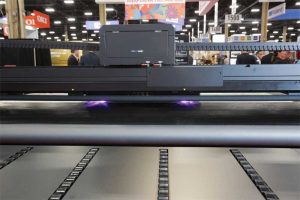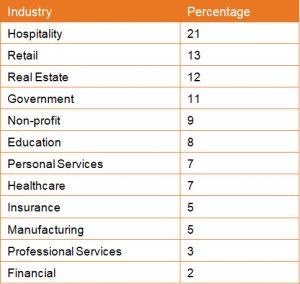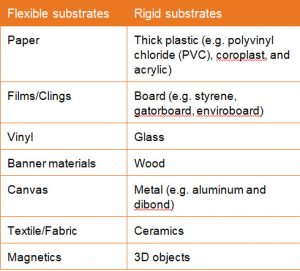Leveraging wide-format applications: What businesses need to know to succeed
by | 18 November 2019 4:37 pm
By Lisa Cross, Eve Padula, and Steve Urmano [1]
[1]
Signs, displays, and specialty graphic applications are powerful communication tools, compelling marketing vehicles, and effective decor enhancers. Ongoing innovations in inkjet printing technologies, inks, and substrates are expanding application opportunities and driving the revenue growth of wide-format providers.
Most people are familiar with traditional wide-format applications such as banners, vehicle graphics, signs, window graphics, and backlit displays. Newer applications include wallpapers, fabric soft signage, industrial products, and apparel, and the list continues to grow. This article aims to educate and offer direction to readers on how to successfully take advantage of these opportunities.
Key application areas and opportunities
 [2]
[2]Digitally printed wallpaper, upholstery, and tiles are just a few of the higher-demand applications in the growing decor market.
Wide-format applications dominate the visual landscape. With today’s technologies, nearly every surface can carry a message or image that was printed on a digital wide-format device. Although the application possibilities are endless, they can be classified into the following broad areas: outdoor graphics, indoor graphics, and point-of-purchase (POP) displays.
Outdoor graphics
These graphics encompass a wide variety of applications that are used outside and must therefore be able to withstand the elements. Typical applications include:
- Building coverings and wraps;
- Flex-face billboards;
- Backlit signage (day and night);
- Banners/fleet graphics;
- Vehicle wraps; and
- Transit/informational signage.
Indoor graphics
As the name implies, these graphics are used in indoor environments and include a wide variety of applications in the following categories:
- Branding promotions;
- Pop-up displays;
- Posters;
- Backlit signage (day and night);
- Exhibition/event graphics;
- Floor/window graphics;
- Backdrops for theatre/TV; and
- Photographic reproductions.
POP displays
These displays are marketing or advertising vehicles placed next to the merchandise they are promoting. POP displays come in many varieties, including:
- Rigid POP displays;
- 3D POP displays;
- Open-box packages/displays; in-store promotions;
- Short-run packaging for prototyping; and
- Short-run packaging for seasonal promotions and one-off events.
Trending applications
 [3]
[3]Wide-format inkjet printers can vary widely in size and price depending on the indoor/outdoor graphics or specialty applications they are used to produce.
Ongoing innovations in inkjet printing devices, inks, coatings, substrates, and finishing equipment are enabling many new and attractive opportunities. The applications that can be produced on wide-format printers encompass a seemingly endless variety of uses and span many industries.
Soft signage
This signage type—printed direct or via a transfer process to fabric—is becoming increasingly appealing to customers due to the higher-end look and feel of the finished graphics. It is also easier to handle/hang, costs less to ship, can be easily reused, and can be used with curved or framed structures.
Short-run packaging and prototyping
The combination of digital wide-format printing with digital cutting has enabled a cost-effective production of short-run packaging and prototypes. Digitally printed packages and labels offer brand managers the flexibility to run smaller quantities for test markets, regional/ethnic products, and seasonal offerings. Digital production eliminates expensive setup costs as well as long lead times for short-run specialized versions or one-to-one personalized packages.
Thermoforming
This is another area that is generating interest in the wide-format market. With thermoforming, a plastic substrate is heated to a pliable temperature, formed to a specific shape using a mould, cooled, and then trimmed to create a usable product. Brand owners, retailers, and manufacturers can use thermoforming to create custom-formed 3D signs, packages, POP displays, vending panels, gaming kiosks, and much more. Digitally printing directly to these materials is much quicker and more cost-effective—it eliminates costly and time-consuming screen/hand painting processes, or pre-printing and laminating to formable plastics.
Decor
Applications like wallpapers, flooring, furniture, and tiles are growing as customers become more familiar with digital wide-format printing’s ability to accommodate shorter runs and faster delivery times for custom and ‘small-batch’ requests.
Market trends driving application growth
 [4]
[4]Outdoor graphics such as vehicle wraps must be able to withstand the elements.
Retailers, event exhibitors, and designers are always seeking the next big thing to make their sign and display graphics stand out. Some of the reasons the above trending applications are experiencing growth include:
- Fabric graphics offer richer, more eye-catching colours that big brand owners usually want. They can be folded, reused, and are also less expensive to ship and install. As a result, soft signage applications are more appealing to users.
- Architects, interior designers, and homeowners are looking to customize their interior environments. Digitally printed wallpaper, upholstery, and tiles are just a few of the higher-demand applications in the growing decor market.
- Wide-format printing is transforming the packaging industry by enabling smaller print runs of custom packaging and labels. Packaging is an attractive print market because it cannot be displaced by electronic alternatives.
Tips for targeting a vertical market
The most successful wide-format providers will actively target the most profitable customers that need their services. By focusing marketing and sales efforts on a targeted vertical industry that requires such applications, providers can make better use of their resources and gain an in-depth understanding of the industry.
Focusing on one (or several) industries offers many benefits to the marketing and operations side of a business, including:
- Tailoring products and services to meet a select industry’s specific needs makes it easier to get that market’s attention and win sales;
- Building the brand’s reputation and positioning it as an industry expert;
- Understanding the nuances of a vertical market generates reality-based sales and marketing messages that demonstrate a clear understanding of prospective customers’ needs. For example, the things that matter to a financial services firm are very different from those that matter to a retail operation. This information can help a company focus all its marketing efforts to drive results; and
- By understanding the specific needs of a target industry, an organization can best leverage its internal capabilities/resources to deliver the right mix of offerings;
- A specialized focus also provides the insight necessary to develop new, high-demand applications;
- To win business, it is important to ‘talk the talk’ or speak the language of the customer’s industry and truly understand the terminology.
Identifying vertical market opportunities
As almost all the industries use wide-format applications, there are a number of vertical market opportunities to consider. When identifying the sectors that are the best fit for an organization, it is impostant to start by asking the following questions:
- Who are the customers?
First, evaluate the company and its customers. Identify the most profitable consumers by answering the following:
- Why is the company successful today?
- Who are the customers?
- What markets do they serve?
- What are the key characteristics of the market’s existing consumer base with regard to size, profitability, products/services, and challenges?
- Can more products/services be sold to those customers?
- What do the customers want?
Think about the applications the business currently offers—what is the most profitable and which ones do customers perceive as having the most value? What are the critical market trends in the industries the company serves, and how will these trends impact the applications the business currently offers or is considering?
- Why should customers buy from the company?
Individual buyers and organizations evaluate products and services to determine whether or not they provide
the desired benefits. As part of a company’s targeted marketing approach, one must develop a strong value proposition—a 30-second ‘elevator pitch’ to outline the benefits of a product/service or how it is better than competing offers. The value proposition answers the
key question, “Why should a buyer purchase a product from a particular company?”
Key verticals buying wide-format applications
 [5]Many industries purchase wide-format applications, but some spend more than others. In a research study by Keypoint Intelligence, InfoTrends identified the percentage of print budget spending on signage by key industries. The study surveyed more than 1000 small and medium-sized businesses across 12 industries. Respondents were asked to think about the communication materials they printed and were then asked to specify the percentage that signage (e.g. posters, banners, presentation boards) represented for overall print spending. The results were as follows:
[5]Many industries purchase wide-format applications, but some spend more than others. In a research study by Keypoint Intelligence, InfoTrends identified the percentage of print budget spending on signage by key industries. The study surveyed more than 1000 small and medium-sized businesses across 12 industries. Respondents were asked to think about the communication materials they printed and were then asked to specify the percentage that signage (e.g. posters, banners, presentation boards) represented for overall print spending. The results were as follows:
Technology requirements
The possibilities for wide-format applications are endless. An important step in determining which applications to offer is to ensure one has the right printing equipment. Wide-format inkjet printers can vary widely in size and price depending on the indoor/outdoor graphics or specialty applications they are used to produce. Inkjet printers use piezoelectric printheads to deposit tiny droplets of ink directly onto a substrate. The ink is bonded or cured to the substrate using thermal heat or light (e.g. a heater or ultraviolet [UV] lamp system), depending on the ink type.
There are three primary types of wide-format printers: flatbed, roll-to-roll, and hybrid systems (capable of printing rolled as well as flat substrates). Each printing technology has its own strengths and limitations, so the applications one produces—now and in the future—can help dictate the printer type that is right for the business.
Substrate considerations
A key benefit of wide-format devices is they can print on a range of media types. Overall, substrates can be rigid
or flexible. Printing devices (roll-fed, flatbed, or hybrid) typically dictate the type of substrates (rigid, flexible, or both) that can be used, but there are many media options for each type. The table below lists some common substrate types:
Here are some key questions to ask when selecting substrates for various applications:
- Will the print be exposed to sunlight, UV radiation, moisture, or extreme temperatures?
- How long does the print need to last?
- Will the print be displayed more than once?
- Where and how will the print be installed?
- What special effects are required?
The role of special effects and ink technology

Ongoing advancements in technology and ink are creating new opportunities to produce higher-margin applications featuring special print effects. These premium applications have the potential to increase sales and accelerate profits. Some of the effects and techniques that can be considered include:
White ink
White ink expands both the range and quality of applications that can be produced. It is becoming increasingly popular, largely due to technological improvements related to opacity and printer productivity. By first printing an opaque white layer, printers can produce stunning images on an array of non-traditional substrates. White ink can also create a strong impact when printing on clear adhesives and dark or metallic substrates.
In addition to enabling printing on a broader array of substrates (including transparent and dark materials), white ink increases the type of work an organization can add to its service offerings, including the creation of special effects. White ink is often required for package printing and prototyping, as well as backlit displays and window clings printed on transparent media.
Clear ink
Clear ink can be used to achieve certain visual effects. When clear varnish covers an entire printed sheet for protection
or sheen, it is known as ‘flood coating.’ Alternatively, spot varnish helps to highlight areas of a printed piece, adding shine and depth to specific elements (e.g. a logo or image).
Backlight
Backlit displays offer a luminous quality and create the appearance of depth, making a graphic dynamic, interactive, and more memorable. In addition to creating an eye-catching focal point, backlit signage can also deliver a pop of colour. Special techniques can be used to create dynamic dual day/night backlit displays as well.
Thermoforming
Thermoforming inks remove the limitations of working with thermoformed applications, opening new productivity routes for firms that want to increase revenues and gain
a competitive advantage from high-impact 3D signs and graphics. These digital UV-curable inks enable wide-format providers to print directly onto thermoplastic sheets, which can then be formed into deep draw, high-elongation parts with superior retention of hue and opacity. These inks eliminate a number of labour-intensive and costly methods that once existed when working with shaped and irregular surfaces, such as hand-airbrushing.
Staffing
Ongoing training of staff members on new applications and/or special effects is essential for supporting customers. Many equipment vendors will have a technical representative on staff to help educate employees or provide other forms of training support. Industry trade shows and conferences can also play a key role in strengthening employee knowledge of print applications.
Education
Customers need to be educated on the types of wide-format applications that are available and the value they deliver. Creating and distributing print samples, donating signs (including the company’s contact information) to charitable organizations or schools, producing customer case studies on application successes, and hosting customer open house events are all great ways to educate customers while promoting the company’s services.
Hosting a customer event is often an untapped opportunity. Allowing customers and prospects into a business operation to meet with staff members, see the equipment, and learn about the various applications can help them better understand why they should purchase from the company. Social media is another important tool for education and marketing. It is a great vehicle for highlighting a business’s applications.
Wide-format work is visual by nature, so leveraging social media to demonstrate applications in a real-world setting can show customers and prospects what the company is capable of. Once they have seen what the business can do, they are more likely to want it for themselves.
This article is based on a white paper the authors prepared for the International Sign Association (ISA). For more information, visit www.signs.org.
Lisa Cross is the associate director for Keypoint Intelligence—InfoTrends’ business development strategies service. She is responsible for conducting market research, advising customers on communication strategy, overseeing content creation, and managing custom consulting projects. Previously an industry journalist, Cross has more than 20 years of experience in covering and reporting on the graphic communications industry.
Eve Padula is the senior research analyst for Keypoint Intelligence—InfoTrends’ business development strategies, customer communications, and wide-format consulting services. Her responsibilities include the promotion and distribution of content, assisting in building business development programs, handling data analysis, and managing the editing cycle for many types of deliverables.
Steve Urmano is the director of InfoTrends’ wide-format printing consulting service. He develops InfoTrends’ annual global market forecasts for hardware and supplies used in the wide-format printing markets.
He is responsible for conducting annual research studies in the wide-format market both on a custom basis and as part of InfoTrends’ syndicated research.
- [Image]: https://www.signmedia.ca/wp-content/uploads/2019/11/2Q0A9387.jpg
- [Image]: https://www.signmedia.ca/wp-content/uploads/2019/11/2Q0A9228.jpg
- [Image]: https://www.signmedia.ca/wp-content/uploads/2019/11/Product-44-of-54.jpg
- [Image]: https://www.signmedia.ca/wp-content/uploads/2019/11/Product-47-of-54.jpg
- [Image]: https://www.signmedia.ca/wp-content/uploads/2019/11/illustrator1.jpg
Source URL: https://www.signmedia.ca/leveraging-wide-format-applications-what-businesses-need-to-know-to-succeed/